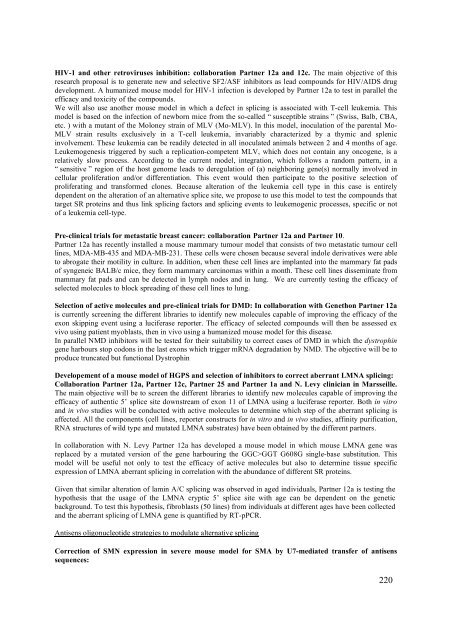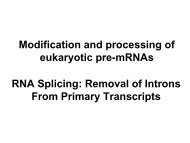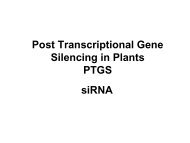Create successful ePaper yourself
Turn your PDF publications into a flip-book with our unique Google optimized e-Paper software.
HIV-1 and other retroviruses inhibition: collaboration Partner 12a and 12c. The main objective of thisresearch proposal is to generate new and selective SF2/ASF inhibitors as lead compounds for HIV/AIDS drugdevelopment. A humanized mouse model for HIV-1 infection is developed by Partner 12a to test in parallel theefficacy and toxicity of the compounds.We will also use another mouse model in which a defect in splicing is associated with T-cell leukemia. Thismodel is based on the infection of newborn mice from the so-called “ susceptible strains ” (Swiss, Balb, CBA,etc. ) with a mutant of the Moloney strain of MLV (Mo-MLV). In this model, inoculation of the parental Mo-MLV strain results exclusively in a T-cell leukemia, invariably characterized by a thymic and splenicinvolvement. These leukemia can be readily detected in all inoculated animals between 2 and 4 months of age.Leukemogenesis triggered by such a replication-competent MLV, which does not contain any oncogene, is arelatively slow process. According to the current model, integration, which follows a random pattern, in a“ sensitive ” region of the host genome leads to deregulation of (a) neighboring gene(s) normally involved incellular proliferation and/or differentiation. This event would then participate to the positive selection ofproliferating and transformed clones. Because alteration of the leukemia cell type in this case is entirelydependent on the alteration of an alternative splice site, we propose to use this model to test the compounds thattarget SR proteins and thus link splicing factors and splicing events to leukemogenic processes, specific or notof a leukemia cell-type.Pre-clinical trials for metastatic breast cancer: collaboration Partner 12a and Partner 10.Partner 12a has recently installed a mouse mammary tumour model that consists of two metastatic tumour celllines, MDA-MB-435 and MDA-MB-231. These cells were chosen because several indole derivatives were ableto abrogate their motility in culture. In addition, when these cell lines are implanted into the mammary fat padsof syngeneic BALB/c mice, they form mammary carcinomas within a month. These cell lines disseminate frommammary fat pads and can be detected in lymph nodes and in lung. We are currently testing the efficacy ofselected molecules to block spreading of these cell lines to lung.Selection of active molecules and pre-clinical trials for DMD: In collaboration with Genethon Partner 12ais currently screening the different libraries to identify new molecules capable of improving the efficacy of theexon skipping event using a luciferase reporter. The efficacy of selected compounds will then be assessed exvivo using patient myoblasts, then in vivo using a humanized mouse model for this disease.In parallel NMD inhibitors will be tested for their suitability to correct cases of DMD in which the dystrophingene harbours stop codons in the last exons which trigger mRNA degradation by NMD. The objective will be toproduce truncated but functional DystrophinDevelopement of a mouse model of HGPS and selection of inhibitors to correct aberrant LMNA splicing:Collaboration Partner 12a, Partner 12c, Partner 25 and Partner 1a and N. Levy clinician in Marsseille.The main objective will be to screen the different libraries to identify new molecules capable of improving theefficacy of authentic 5’ splice site downstream of exon 11 of LMNA using a luciferase reporter. Both in vitroand in vivo studies will be conducted with active molecules to determine which step of the aberrant splicing isaffected. All the components (cell lines, reporter constructs for in vitro and in vivo studies, affinity purification,RNA structures of wild type and mutated LMNA substrates) have been obtained by the different partners.In collaboration with N. Levy Partner 12a has developed a mouse model in which mouse LMNA gene wasreplaced by a mutated version of the gene harbouring the GGC>GGT G608G single-base substitution. Thismodel will be useful not only to test the efficacy of active molecules but also to determine tissue specificexpression of LMNA aberrant splicing in correlation with the abundance of different SR proteins.Given that similar alteration of lamin A/C splicing was observed in aged individuals, Partner 12a is testing thehypothesis that the usage of the LMNA cryptic 5’ splice site with age can be dependent on the geneticbackground. To test this hypothesis, fibroblasts (50 lines) from individuals at different ages have been collectedand the aberrant splicing of LMNA gene is quantified by RT-pPCR.Antisens oligonucleotide strategies to modulate alternative splicingCorrection of SMN expression in severe mouse model for SMA by U7-mediated transfer of antisenssequences:220







